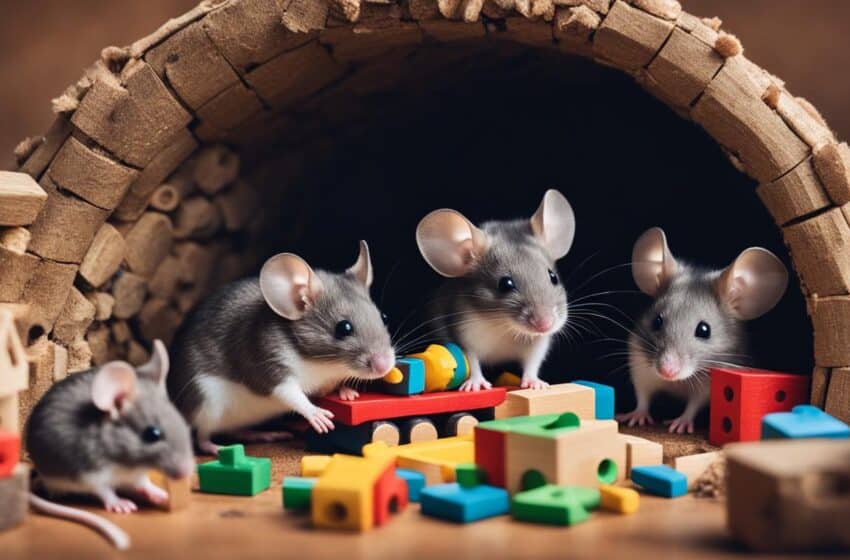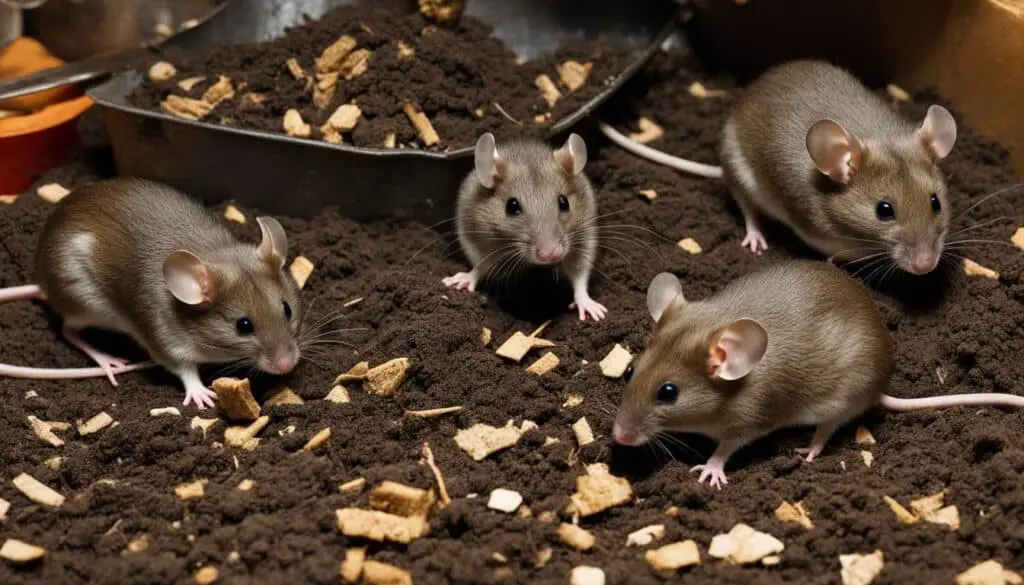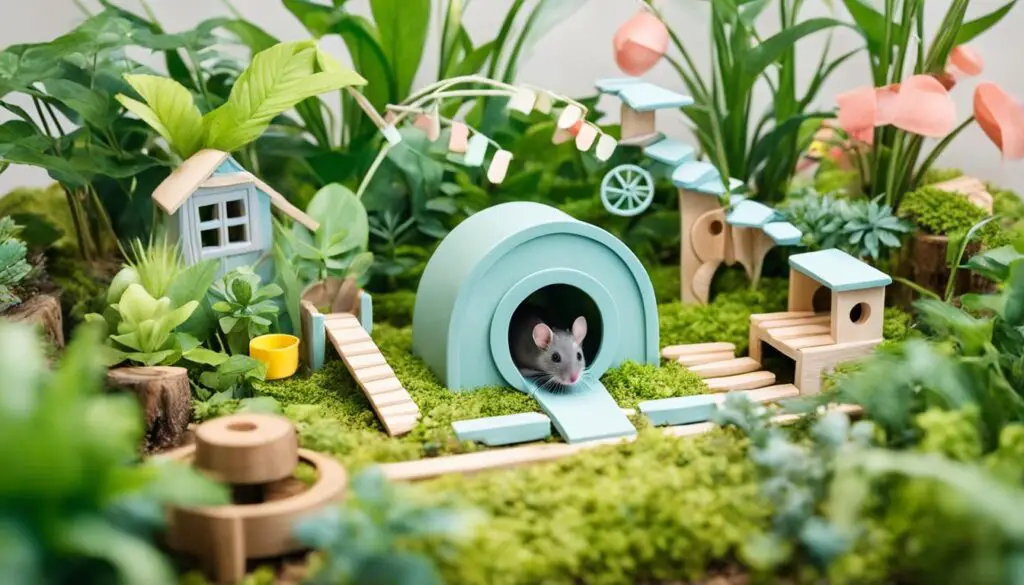Reducing Stress in Pet Mice: Effective Strategies

Stress can have a detrimental impact on the health and well-being of our beloved pet mice. As responsible caretakers, it is essential for us to understand the causes of stress and implement effective strategies to minimize its occurrence. By creating a calm environment, providing enrichment activities, and promoting social interaction, we can significantly reduce stress levels in our furry companions.
Research has shown that reducing stress in pet mice not only enhances their overall health, but also improves their behavior. These small creatures thrive in an environment that is conducive to their well-being, allowing them to lead happier, healthier lives.
Key Takeaways:
- Create a calm environment for your pet mice by providing spacious and enriching enclosures.
- Offer a variety of toys and materials to keep their environment stimulating and engaging.
- Promote social interaction by keeping pet mice in same-sex pairs or small groups.
- Schedule regular playtime and provide mental stimulation through food puzzles and training exercises.
- Observe your mice’s behavior and make adjustments when necessary to ensure their well-being.
Understanding the Causes of Stress in Pet Mice
As responsible pet owners, it is crucial to recognize the potential causes of stress in our beloved pet mice. By identifying the triggers, we can develop effective strategies to alleviate their stress and ensure their well-being. Let’s take a closer look at some common causes of stress in pet mice:
- Overcrowding: Pet mice are social animals, but overcrowding can lead to territorial disputes and increased stress levels.
- Changes in Environment: Mice are creatures of habit, and sudden changes in their surroundings can trigger stress. This includes moving their enclosure or introducing new objects or scents.
- Loud Noises: Mice have sensitive hearing, and loud noises can be overwhelming. This can include household appliances, music, or even nearby construction.
- Inadequate Housing: Mice require a clean, comfortable, and spacious habitat. Inadequate housing that lacks proper ventilation, enrichment, or hiding spots can contribute to stress.
- Social Isolation: Loneliness and lack of social interaction can cause stress in pet mice. They thrive on companionship and should be housed with compatible same-sex cage mates.
Understanding these causes of stress in pet mice is the first step towards creating a calm and nurturing environment for them. It allows us to tailor our stress reduction strategies to address these specific triggers. By doing so, we can ensure our furry friends live happier and healthier lives.
Expert Insight:
“Pet mice are highly susceptible to stress, and it is crucial to identify the causes to mitigate their negative effects. Overcrowding, changes in their environment, loud noises, inadequate housing, and social isolation are significant stressors to consider. By minimizing or eliminating these triggers, we can promote the overall well-being of our pet mice.” – Dr. Emily Rodriguez, Small Animal Veterinarian

| Causes of Stress | Potential Impact |
|---|---|
| Overcrowding | Increased aggression, territorial disputes |
| Changes in Environment | Anxiety, fear, disrupted routine |
| Loud Noises | Heightened stress response, fear, decreased appetite |
| Inadequate Housing | Restlessness, boredom, compromised immune system |
| Social Isolation | Loneliness, depression, decreased overall well-being |
Creating a Calm Environment for Pet Mice
Creating a calm environment for your pet mice is crucial in reducing their stress levels. By providing them with a spacious and enriching enclosure, you can ensure their well-being and promote a healthier lifestyle for your furry companions.
Consider incorporating the following elements into their living space:
- Hiding Spots: Provide your pet mice with plenty of hiding spots, such as small tunnels or cozy nests, where they can retreat to when they feel overwhelmed or anxious.
- Tunnels: Adding tunnels to their enclosure not only creates a stimulating environment but also mimics their natural habitat. This allows them to explore and engage in playful activities.
- Climbing Structures: Pet mice love to climb, so incorporating climbing structures like branches or ladders can help keep them physically active and mentally stimulated.
Keeping their living space clean and well-ventilated is also essential. Regularly remove any soiled bedding or debris, and ensure proper ventilation to maintain a fresh and odor-free environment for your pet mice.
Avoid exposing them to loud noises and sudden temperature changes, as these can be stressful for them. Place their enclosure in a quiet area away from loud appliances or activities. Additionally, ensure that the room temperature remains stable, avoiding extreme fluctuations.
Remember, a calm environment is key to reducing stress and promoting the well-being of your pet mice. By incorporating these strategies, you can create a comfortable and peaceful space for your furry friends to thrive.

Creating a spacious and enriching enclosure with hiding spots, tunnels, and climbing structures is crucial in reducing stress levels in pet mice. Providing a clean and well-ventilated living space, while avoiding loud noises and sudden temperature changes, creates a calm environment where your mice can feel safe and secure.
Implementing Enrichment Activities
Enrichment activities are essential for reducing stress and promoting the well-being of pet mice. These activities provide mental stimulation, encourage natural behaviors, and prevent boredom. By integrating a variety of toys and interactive elements into their environment, you can create a stimulating and engaging space for your furry companions.
One of the key aspects of enrichment activities for pet mice is providing them with a range of toys to interact with. Consider offering chew toys, tunnels, and exercise wheels to cater to their physical and exploratory needs. These toys not only provide entertainment but also support their dental health by encouraging gnawing behavior.
“Providing a combination of textures and materials is crucial to keep pet mice engaged and curious.”
Offering different textures and materials for your mice to explore and gnaw on is crucial. Soft bedding materials, such as shredded paper or fabric strips, provide comfort and nesting opportunities. Additionally, natural materials like twigs or branches can serve as climbing structures and offer a sense of the outdoors. Ensuring a variety of textures and materials will keep your pet mice interested and their environment stimulating.
“Rotate and introduce new toys regularly to prevent habituation and maintain interest.”
To prevent habituation and keep your pet mice engaged, it is important to rotate their toys and introduce new ones regularly. Mice are intelligent and curious creatures, making them eager to explore unfamiliar objects. By periodically changing their toys, you can stimulate their minds and prevent boredom.
Remember to observe your pet mice during playtime and identify their preferences. Some mice may enjoy interactive puzzle toys that challenge their problem-solving skills, while others may prefer toys that encourage physical activity. Catering to their individual needs and interests will enhance their enrichment experience.
| Enrichment Activity | Description |
|---|---|
| Chew Toys | Toys made of safe, non-toxic materials that encourage gnawing behavior and support dental health. |
| Tunnels | Includes tubes or tunnels that allow mice to explore and create secure hideouts. |
| Exercise Wheels | Provides an opportunity for physical exercise and entertainment. |
| Soft Bedding | Offer materials like shredded paper or fabric strips for nesting and comfort. |
| Natural Twigs/Branches | Allow mice to climb, explore, and chew on safe, untreated natural materials. |
| Interactive Puzzle Toys | Provides mental stimulation and challenges mice’s problem-solving skills. |
Social Interaction and Mental Stimulation
Pet mice are highly social animals that thrive on interaction and companionship. Providing them with opportunities for socializing and mental stimulation is essential for their overall well-being.
One way to ensure social interaction for pet mice is by keeping them in same-sex pairs or small groups, as long as they are compatible. This allows them to engage in natural behaviors such as grooming, playing, and communicating with each other. It is important to introduce mice gradually and monitor their interactions to ensure they get along well.
Scheduling regular playtime with your pet mice is another effective way to provide social interaction and mental stimulation. Allow them to explore safe areas outside their enclosure, such as a mouse-proof room or a playpen. This gives them the opportunity to exercise, discover new environments, and interact with you in a controlled and stimulating setting.
In addition to social interaction, mental stimulation is crucial for the mental well-being of pet mice. Providing them with environmental enrichment, such as food puzzles and treat dispensers, engages their natural foraging instincts and keeps them mentally engaged. You can also try training exercises like teaching them tricks or simple commands, which provide mental challenges and strengthen the bond between you and your mice.
Benefits of Social Interaction and Mental Stimulation for Pet Mice
The benefits of social interaction and mental stimulation for pet mice are numerous. These activities not only prevent boredom but also promote physical and mental health. When mice have companionship and engaging experiences, they are less likely to exhibit stress-related behaviors such as excessive grooming, aggression, or self-harm.
Regular social interaction and mental stimulation can also contribute to improved cognitive function, preventing cognitive decline in older mice. It keeps their brains active and helps them develop problem-solving skills.
Furthermore, socializing and mentally stimulating mice create a stronger bond between them and their owners. It fosters trust and socialization with humans, making handling and interaction easier and more enjoyable for both parties.
Summary
Social interaction and mental stimulation are crucial aspects of caring for pet mice. By providing them with companionship, scheduling regular playtime, and offering activities that engage their minds, you can enhance their overall well-being and create a stronger bond with your furry friends.
Conclusion
In conclusion, stress reduction plays a significant role in the overall well-being of pet mice. By understanding the causes of stress and implementing effective strategies, such as creating a calm environment, providing enrichment activities, and promoting social interaction, you can ensure a happier and healthier life for your pet mice.
Creating a calm environment for your pet mice is essential. Providing them with a spacious and enriching enclosure with hiding spots, tunnels, and climbing structures can help reduce their stress levels. Keeping their living space clean and well-ventilated and avoiding exposure to loud noises and sudden temperature changes are also crucial factors in creating a calm environment.
In addition to a calm environment, enrichment activities are vital for reducing stress in pet mice. Offering a variety of toys, such as chew toys, tunnels, and exercise wheels, and providing different textures and materials for them to explore and gnaw on can keep their environment stimulating. Regularly rotating and introducing new toys will further promote mental stimulation.
Lastly, social interaction is key to reducing stress and promoting the well-being of pet mice. Keeping them in same-sex pairs or small groups, as long as they are compatible, and scheduling regular playtime outside their enclosure for exploration can provide the necessary social interaction they need. Mental stimulation can be achieved through food puzzles, treat dispensers, and training exercises.
FAQ
What are the common causes of stress in pet mice?
Common causes of stress in pet mice include overcrowding, changes in their environment, loud noises, inadequate housing, and social isolation.
How can I create a calm environment for my pet mice?
You can create a calm environment for your pet mice by providing them with a spacious and enriching enclosure, keeping their living space clean and well-ventilated, and avoiding exposure to loud noises and sudden temperature changes.
What role do enrichment activities play in reducing stress in pet mice?
Enrichment activities play a vital role in reducing stress and promoting the well-being of pet mice. Providing them with a variety of toys, such as chew toys, tunnels, and exercise wheels, and offering different textures and materials for them to explore and gnaw on can help reduce their stress levels.
How can I promote social interaction and mental stimulation for my pet mice?
You can promote social interaction and mental stimulation for your pet mice by keeping them in same-sex pairs or small groups, scheduling regular playtime outside their enclosure, and providing them with activities such as food puzzles, treat dispensers, and training exercises.
Why is stress reduction important for the well-being of pet mice?
Stress reduction plays a significant role in the overall well-being of pet mice. By understanding the causes of stress and implementing effective strategies, such as creating a calm environment, providing enrichment activities, and promoting social interaction, you can ensure a happier and healthier life for your pet mice.



